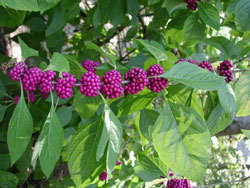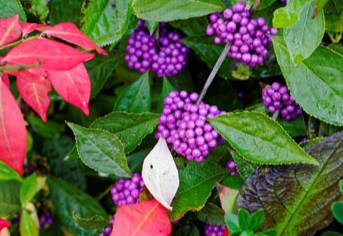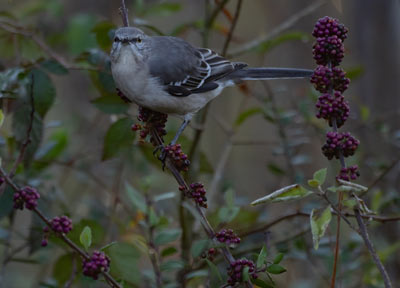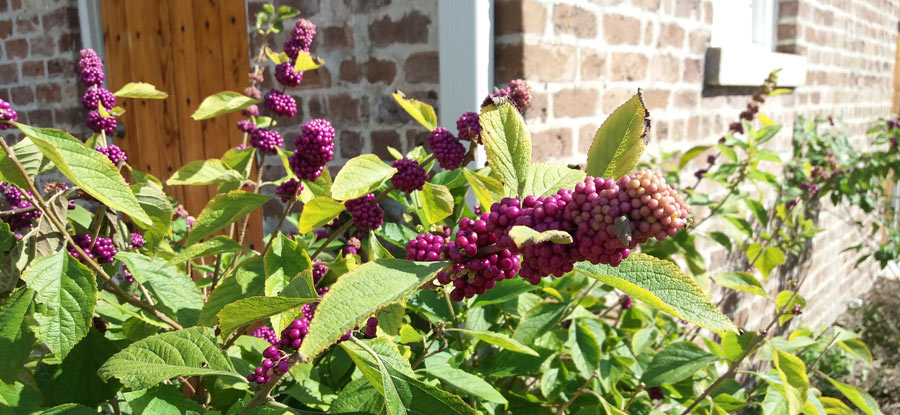Resource Library
Plant of the Week: Beautyberry, American
The University of Arkansas System Division of Agriculture does not promote, support or recommend plants featured in "Plant of the Week." Please consult your local Extension office for plants suitable for your region.
Plant of the Week
[A-Z]
American Beautyberry
Latin: (Callicarpa Americana)

Fall is the harvest season, so it is not surprising many native shrubs take advantage of the season to ripen their own fruit before winter arrives. One of these, American beautyberry (Callicarpa americana), is so stunningly beautiful in the fall it is hard to overlook.
American beautyberry, also widely known as French mulberry, even though it is neither French nor a mulberry, produces luminescent purple clusters of fruit that are almost without equal in the garden. It is an open, sprawling native deciduous shrub growing 6 to 8 feet tall and wide with a natural range from Virginia to East Texas. This is the only species of the 130 that have been described native to the continental United States. It is a member of the verbena family.
Distinctive Features of the American Beautyberry
Beautyberry is a coarse shrub with slender, arching stems bearing 4-to 6-inch long opposite leaves that have the texture and general look of red mulberry, Morus rubra.
In midsummer clusters of tiny lavender-pink flowers with protruding stamens are produced
at the leaf axils amongst the foliage on new growth. Flowers, while not especially
showy, are perfect with male and female parts.  Cross-pollination often provides for better fruit set come autumn.
Cross-pollination often provides for better fruit set come autumn.
Flowering and Fruit Production
In the fall, beginning about the first of October and lasting until Thanksgiving, the bb-sized berries turn shades of purple and lavender.
A white-fruited form is also common in the wild and in commerce. The clusters of berries are to an inch-and-half across.
Wildlife Benefits and Natural Uses
 Beautyberry is found growing wild along roadways and in thickets under pine trees
in areas where winter temperatures do not drop below 10 degrees F. Its berries are
used by at least 10 species of songbirds and the foliage is a favorite browse for
deer.
Beautyberry is found growing wild along roadways and in thickets under pine trees
in areas where winter temperatures do not drop below 10 degrees F. Its berries are
used by at least 10 species of songbirds and the foliage is a favorite browse for
deer.
Crushed leaves can be used as a deterrent for mosquitoes and ticks should you find yourself under attack in the woods.
Cultivating American Beautyberry in Gardens
In gardens American beautyberry can be grown in zone 6 but then it is best treated as an herbaceous perennial and cut to the ground each spring. Because it fruits on new growth, cutting the plant to the ground every winter is a good idea because it gives the often-rangy plant a better landscape appearance. C. dichotoma, purple beautyberry, is a Japanese species that grows 3 feet tall and wide and is cold hardy to zone 5.
Soil and Sunlight Preferences
American beautyberry grows in a wide range of soils but is best in sandy loam soils that don’t get too dry from midsummer onwards as the fruit develop. It will flower and fruit in medium to heavy shade but fruit load and visual impact is better if plants get at least some direct sunlight during the day.
Landscape Uses for American Beautyberry
It is ideally suited for massing in the wild garden or for use at the edge of the woodland garden. Single plants can be added to the back of an herbaceous border.

By: Gerald Klingaman, retired
Extension Horticulturist - Ornamentals
Extension News - November 21, 2008
The University of Arkansas System Division of Agriculture does not maintain lists of retail outlets where these plants can be purchased. Please check your local nursery or other retail outlets to ask about the availability of these plants for your growing area.